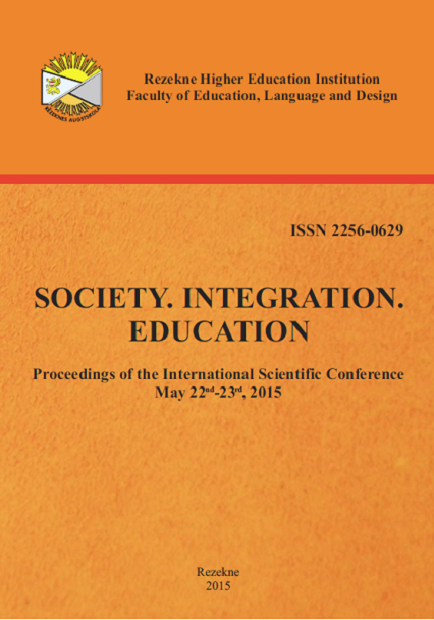Professional Attitude of Physical Education Teachers toward Education Process of Students with Severe Intellectual Disabilities
DOI:
https://doi.org/10.17770/sie2015vol3.480Keywords:
physical education, professional attitude of physical education teachers, severe intellectual disabilityAbstract
Physical education teachers face many challenges when teaching students with severe intellectual disability (SID) because of extensive adaptations and assistance they need. The purpose of this study was to determine attitude of PE teachers in Latvia and Lithuania toward teaching students with SID in the special education environment. Method: Participants were 84 PE teachers from special schools. The Survey of Physical Education Teachers’ Attitude Toward Teaching Students with SID (Strazdina & Klavina, 2012) was used. Results and Conclusions: Results revealed significant differences in results across teachers’ age, gender and work experience. Latvian teachers' beliefs were more positive towards teaching students with SID than teachers in Lithuania. Stepwise multiple regressions analyses demonstrated that overall there was significant relationship between predictors and behavioral intention.
References
Ajzen, I. (1991). The theory of planned behavior. Organization Behavior and Human Decision Process, 50, 179-211
Ajzen, I., & Fishbein, M. (1980). Understanding attitudes and predicted social behavior. Englewood Cliffs, NJ: Prentice Hall.
Conatser, P., Block, M., & Gansneder, B. (2002). Aquatic instructors’ beliefs toward inclusion: The Theory of Planned Behavior. Adapted Physical Activity Quarterly, 19, 172-187.
Fishbein, M., & Ajzen, I. (1975). Belief, attitude, intention, and behavior: An introduction to theory and research. Reading, MA: Addison-Wesley.
Grunbaum, J., Kann, L., Kinchen, A. (2002) Methodology of the Youth Risk Behavior Surveillance System. National Center for Chronic Disease Prevention and Health Promotion, P. 45.
Jeong, M., & Block, M.E. (2011). Physical education teachers’ beliefs and intentions towards teaching students with disabilities. Research Quarterly for Exercise and Sport. 82, 1-8.
Jurgena I., (2002). Vispārīgā pedagoģija. Rīga, 2002. 144 lpp.
Klavina, A. (2008). Using peer-mediated instructions for students with severe and multiple disabilities in inclusive physical education: A multiple case study. EuropeanJournal in Adapted Physical Activity, 1(2), 7-19
Klavina, A., & Block, M. (2008). The effect of peer tutoring on interaction behaviors in inclusive physical education. Adapted Physical Activity Quarterly, 25, 132–158.
Kudlacek, M., Valkova, H., Sherrill, C., Myers, B., & French, R. (2002).An inclusion instrument based on planned behavior theory for prospective Czech physical educators. Adapted Physical Activity Quarterly, 19, 280-299
Lienert, C., Sherrill, C., & Myers, B. (2001). Physical educators’ concerns about integrating children with disabilities: A cross-cultural comparison. Adapted Physical Activity Quarterly, 18, 1–17.
Place, K., & Hodge, S.R. (2001). Social inclusion of students with physical disabilities in GPE: A behavioral analysis. Adapted Physical Activity Quarterly, 18, 389–404.
Rimmer, J., Rowland, Y., Yamaki, Y. (2007) Documenting Disparities in Obesity and Disability. National Center for the Dissemination of Disability Research. P. 16.
Rizzo, T.L. (1984). Attitudes of physical educators toward teaching handicapped pupils. Adapted Physical Education Quarterly, 1, 267–274.
Stabiņš, J. (2001). Skolotāja misija. Rīga, RaKa, 2001. 59.
Steelee, A., Rossen, B., Biggar, D. (2004). Age-related health risk behaviors of adolescents with physical disabilities. Journal of disability, 2004. P.132-141.
Strazdina, N., & Klavina, A. (2013). Physical education teachers’ attitude toward learning process of students with severe intellectual disabilities. International Symposium in Adapted Physical Activities, Istanbul (Turkey), Abstract Book 138. lpp.
Theodorakis, Y., Bagiatis, K., & Goudas, M. (1995). Attitudes toward teaching individuals with disabilities: Application of planned behavior theory. Adapted Physical Activity Quarterly, 18 (12), 151-160.
Vogler, E.W., Koranda, P., & Romance, T. (2000). Including children with severe cerebral palsy in physical education: A case study. Adapted Physical Activity Quarterly, 17, 161–175.
Interneta resursi
Pilotpētījums. Interešu izglītība Latvijas speciālās skolās (2007). Sabiedrības integrācijas fonds. [skatīts 20.02.2015.] Pieejams: www.barenubiedriba.lv
Skolotāju izglītība iekļaušanai. Iekļaujošu skolotāju profils. (2012). Eiropas speciālās izglītības attīstības aģentūra. [skatīts 20.02.2015.]. Pieejams: https://www.european-agency.org/sites/default/files/te4i-profile-of-inclusive-teachers_Profile-of-Inclusive-Teachers-LV.pdf
LR IZM. Izglītība. Attīstība. Tendences. (2014). 2014./2015.mācību gada aktualitātes un jaunumi IAP 2014-2020 kontekstā. 2014.gada 21.augusts. [skatīts 20.02.2015.]. Pieejams: http://izm.izm.gov.lv/upload_file/2014/aktualitates
LR IZM (2014). Izglītības un zinātnes ministrija 2013.gada publiskais pārskats. LR IZM, 2014. [skatīts 20.02.2015.]. Pieejams: http://izm.izm.gov.lv/






